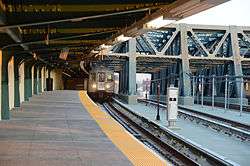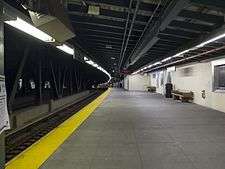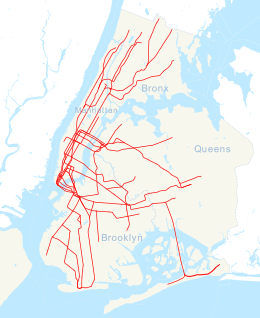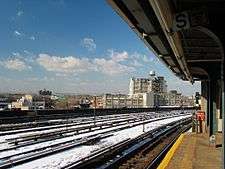Smith–Ninth Streets (IND Culver Line)
| Smith–Ninth Streets | |||||||
|---|---|---|---|---|---|---|---|
| New York City Subway rapid transit station | |||||||
 | |||||||
| Station statistics | |||||||
| Address |
Smith Street & Ninth Street Brooklyn, NY 11231 | ||||||
| Borough | Brooklyn | ||||||
| Locale | Gowanus | ||||||
| Coordinates | 40°40′27.3″N 73°59′48.63″W / 40.674250°N 73.9968417°WCoordinates: 40°40′27.3″N 73°59′48.63″W / 40.674250°N 73.9968417°W | ||||||
| Division | B (IND) | ||||||
| Line | IND Culver Line | ||||||
| Services |
F G | ||||||
| Transit connections |
| ||||||
| Structure | Elevated | ||||||
| Platforms | 2 side platforms | ||||||
| Tracks | 4 (2 in regular service) | ||||||
| Other information | |||||||
| Opened | October 7, 1933 | ||||||
| Traffic | |||||||
| Passengers (2015) |
1,636,221[1] | ||||||
| Rank | 292 out of 422 | ||||||
| Station succession | |||||||
| Next north |
Carroll Street: F | ||||||
| Next south |
Fourth Avenue: F | ||||||
| |||||||
| |||||||
Smith–Ninth Streets is a local station on the IND Culver Line of the New York City Subway. It is located over the Gowanus Canal between Smith and Ninth Streets in Gowanus, Brooklyn and is served by the F and G trains at all times.
This elevated station, opened on October 7, 1933, has four tracks and two side platforms. In 2009, the Metropolitan Transportation Authority began an extensive renovation of the station, which was closed entirely for a full reconstruction between June 2011 and April 2013.
History
In 1927, it was decided to build a bridge over the Gowanus Canal for the IND Culver Line, thus replacing earlier plans for a deep river tunnel in the area. This resulted in the only above-ground section of the original IND.[2][3][4] The first short section of the line opened on March 20, 1933, from Jay Street to Bergen Street.[5][6] The rest of the line, including the Smith–9th Streets station, opened on October 7, 1933, to the "temporary" terminal at Church Avenue.[5][7]
Service patterns
The station was originally served by the A train. In 1936, the A was rerouted to the IND Fulton Street Line and E trains from the Queens Boulevard line replaced them.[5] In 1937, the connection to the IND Crosstown Line opened and GG trains were extended to Church Avenue, complementing the E. In December 1940, after the IND Sixth Avenue Line opened, E trains were replaced by the F, and the GG was cut back to Smith–Ninth Streets.[5] Following the completion of the Culver Ramp in 1954,[8][9] D Concourse Express trains replaced F service to Coney Island.[9][10] In November 1967, the Chrystie Street Connection opened and D trains were rerouted via the Manhattan Bridge and the BMT Brighton Line to Coney Island. F trains were extended once again via the Culver Line.[10][11]
The station acted as a local-only station from 1968 to 1976, when F trains ran express in both directions between Bergen Street and Church Avenue during rush hours. The GG was extended from Smith–Ninth Streets to Church Avenue as a result of the express service's inauguration.[12][13] Express service between Bergen and Church ended in 1976 due to budgetary concerns and passenger complaints, and the GG (later renamed the G) was again terminated at the station.[12][13][14][15]
Renovation
.jpg)
In 2007, the MTA announced a three-year, $257.5 million[16] renovation project of the elevated Culver Viaduct, and that for twenty-seven months, this station would be fully or partially closed for a $32 million[17] renovation.[18][19] The renovation was necessitated because the viaduct was falling apart, with leaks and broken concrete riddling the viaduct. The station and the portions of the viaduct near the station had to be encased in a mesh wrapping because there was a significant danger of concrete falling from the viaduct.[20]
On July 5, 2009, the G was extended south at all times to Church Avenue, to allow for overhaul of the Culver Viaduct. On July 19, 2012, the MTA announced that this extension would be permanent.[21]
On January 18, 2011, the second phase of the Culver Viaduct rehabilitation project began, resulting in the closure of the Manhattan-bound platform. This required northbound trains to use the express track and stop at a temporary platform placed over the local track. This shorter platform could only accommodate G trains; F trains bypassed this station on the same track.[22] On June 20, 2011, the station was closed entirely for further renovations,[23] to be reopened in December 2012.[16] However, due to delays and cost overruns,[16] It reopened on April 26, 2013.[24][25] Additional work was performed after the station reopened but it did not affect service.[26] Residents lobbied for an elevator in the station during the renovation, but a spokesman for the MTA said that installation of an elevator was too costly and prohibitive, and that such an elevator would have damaged the station's structural integrity.[26]
Station layout
| 4F | Side platform, doors will open on the right | |
| Northbound local | ← ← | |
| Northbound express | No regular service | |
| Southbound express | No regular service | |
| Southbound local | | |
| Side platform, doors will open on the right | ||
| 3F | - | Crossunder between platforms |
| 2F | - | Escalator mezzanine |
| 1F | Mezzanine | Fare control, station agent |
| G | Street Level | Exit/Entrance |
With an elevation of 87.5 feet (26.7 m), this station is the highest subway station above ground level in the world.[27][28][lower-alpha 1] This elevation was required by now-defunct navigation regulations for tall-mast shipping on the Gowanus Canal, so the bridge rises straight up on four towers by cables.[29] West (railroad north) of this station, the IND Culver Line curves north and enters a tunnel into Carroll Street station. This station and the next station south, Fourth Avenue, were the only original elevated stations built by the IND. All other IND stations were either built underground or taken over from their original owners.[29]
This station and elevated structure are made entirely of concrete. There were green mosaics along the concrete platform walls reading “Smith–9th St” in white sans-serif lettering, which were replaced with laminated replicas during renovations.[30] A close examination of the canopied area suggests windows existed in the past. These were covered for many years and are now open air with safety grates.[31] The station house is on ground level on the north side of 9th Street between Smith Street and the Gowanus Canal. Inside, there is a turnstile bank, token booth, and three long escalators and one staircase going up to a landing, where three more long escalators and one staircase perpendicular for the first set go up to a crossunder. A single staircase then goes up to the western end of either platform.[31]
Entrances and exits
The station has a single exit on Ninth Street east of Smith Street.[32][33]
Gallery
 Lower Manhattan skyline from the station prior to the September 11 attacks
Lower Manhattan skyline from the station prior to the September 11 attacks
 Station logo tilework before renovation
Station logo tilework before renovation- Old entrance

.jpg) Northbound platform at the renovation's completion
Northbound platform at the renovation's completion At night
At night New entrance
New entrance

Notes
References
- ↑ "Facts and Figures: Annual Subway Ridership". Metropolitan Transportation Authority. Retrieved 2016-04-19.
- ↑ "Gay Midnight Crowd Rides First Trains in New Subway". New York Times. September 10, 1932. p. 1.
- ↑ "SUBMITS NEW PLAN FOR BROOKLYN TUBE; Transportation Board Says Revised Project Would Save the City $12,000,000, NO TUNNEL UNDER CANAL Bridge Over Gowanus Stream and Enclosed Viaduct Now Is Proposed.". The New York Times. July 17, 1927. Retrieved November 7, 2015.
- ↑ New York Times, New Subway Routes in Hylan Program to Cost $186,046,000, March 21, 1925, page 1
- 1 2 3 4 "Independent Subway Services Beginning in 1932". thejoekorner.com. August 21, 2013. Retrieved August 2, 2015.
- ↑ New York Times, City Subway Adds Link, March 21, 1933, page 4
- ↑ New York Times, City Subway Extended, October 7, 1933, page 16
- ↑ "NYCTA- Pass for Culver Line Ceremonies - 1954". flickr.com. Retrieved 14 August 2016.
- 1 2 New York Times, Adequate Transit Promised for City, October 29, 1954, page 25
- 1 2 Sparberg, Andrew J. (October 1, 2014). From a Nickel to a Token: The Journey from Board of Transportation to MTA. Fordham University Press. ISBN 978-0-8232-6190-1.
- ↑ Perlmutter, Emanuel (November 16, 1967). "SUBWAY CHANGES TO SPEED SERVICE: Major Alterations in Maps, Routes and Signs Will Take Effect Nov. 26". nytimes.com. The New York Times. Retrieved July 7, 2015.
- 1 2 "Review of F Line Operations, Ridership, and Infrastructure" (PDF). nysenate.gov. MTA New York City Transit Authority. October 7, 2009. Archived from the original (PDF) on 2010-05-31. Retrieved 28 July 2015.
- 1 2 "Feasibility and Analysis of F Express Service in Brooklyn" (PDF). Metropolitan Transportation Authority. May 2016. Retrieved June 24, 2016.
- ↑ Gerberer, Raanan (March 6, 2013). "LIGHT AT END OF TUNNEL: F Train Express may return". brooklyneagle.com. Brooklyn Eagle. Retrieved July 28, 2015.
- ↑ Umanov, Ben (September 22, 2014). "F Train Express Service Might be Coming Back to Brooklyn". gowanusyourfaceoff.com. Gowanus Your Face OFf. Retrieved July 28, 2015.
- 1 2 3 Musumeci, Natalie (2012-12-27). "Smith–Ninth rehab running late, station won't reopen for months". The Brooklyn Paper. Retrieved 2016-07-06.
- ↑ O’Neill, Natalie (2012-03-16). "Smith-Ninth Street station to remain closed till fall". The Brooklyn Paper. Retrieved 2016-07-06.
- ↑ Maldonado, Charles (November 16, 2007). "MTA Gives Brooklyn Board Bad News About Smith–9th St. Closure, F-Train Express". Brooklyn Daily Eagle. Retrieved 2007-11-27.
- ↑ McLaughlin, Mike (November 24, 2007). "Fix for Fourth Avenue station looks F'ing great". The Brooklyn Paper. Retrieved 2007-11-27.
- ↑ "CULVER LINE REHABILITATION" (PDF). brooklyncb6.org. MTA New York City Transit. November 11, 2007. Retrieved July 5, 2016.
- ↑ O'Neill, Natalie (July 19, 2012). "G wiz! MTA plans to save the G train extension!". The Brooklyn Paper. Retrieved 2012-07-21.
- ↑ Kabak, Benjamin (2011-01-04). "A tale of a viaduct, a sign and the need to pay attention". Second Ave. Sagas. Retrieved 2016-07-05.
- ↑ Kral, Georgia (2011-06-20). "Smith & 9th Straphangers Face New, and Longer, Commutes". BoCoCa, NY Patch. Retrieved 2016-07-06.
- ↑ "MTA - news - Smith-9th Sts F/G Station Returns to Service". mta.info. Retrieved 14 August 2016.
- ↑ Newman, Andy (2013-04-26). "City's Highest Subway Station Reopens". The New York Times. Retrieved 2016-07-05.
- 1 2 "Photos: Smith-9th Street Station Finally Reopens But Isn't Handicap Accessible". Gothamist. 2013-04-26. Retrieved 2016-07-06.
- ↑ "Rebuilding the Culver Viaduct". Metropolitan Transportation Authority. January 7, 2011. Retrieved 14 August 2016.
- ↑ BROOKLYN!!, Summer 2013 issue, p.7, caption on photo from station reopening celebration, www.brooklyn-usa.org
- 1 2 Walsh, Kevin (2004-06-20). "UNUSUAL SUBWAY STATIONS". Forgotten New York. Retrieved 2016-07-06.
- ↑ Walsh, Kevin (June 2013). "SMITH-9th STREET STATION – RED HOOK Part 1". Forgotten New York. Retrieved 2016-07-06.
- 1 2 Darlington, Peggy; Pirmann, David. "www.nycsubway.org: IND Crosstown Line: Smith-9th Street". www.nycsubway.org. Retrieved 2016-07-06.
- ↑ "MTA Neighborhood Maps: Red Hook" (PDF). mta.info. Metropolitan Transportation Authority. 2015. Retrieved 2 August 2015.
- ↑ "Review of the G Line: Appendices" (PDF). Metropolitan Transportation Authority. July 10, 2013. Retrieved 28 October 2015.
External links
| Wikimedia Commons has media related to Smith–Ninth Streets (IND Culver Line). |
- nycsubway.org – IND Crosstown: Smith/9th Street
- Station Reporter — F Train
- Station Reporter — G Train
- The Subway Nut — Smith–9th Streets Pictures
- Ninth Street entrance after renovation from Google Maps Street View
- Platforms from Google Maps Street View






